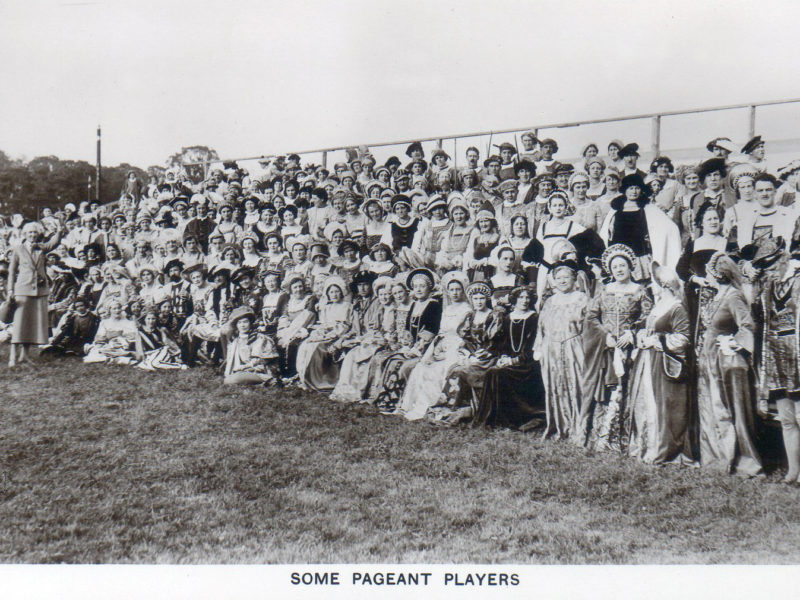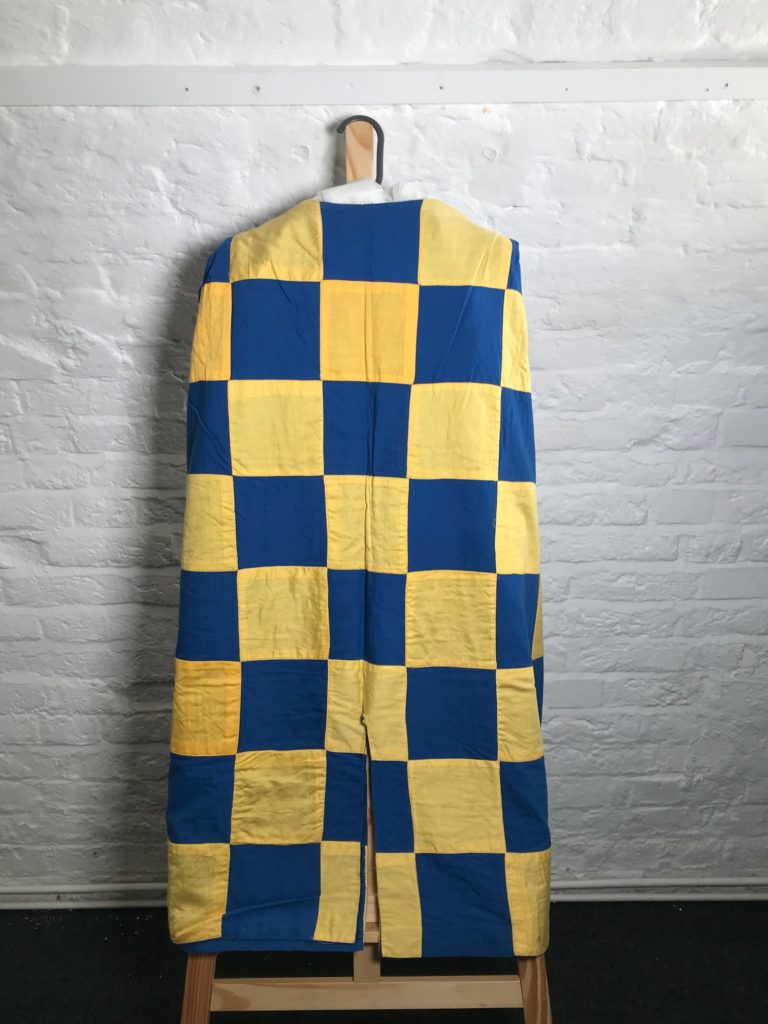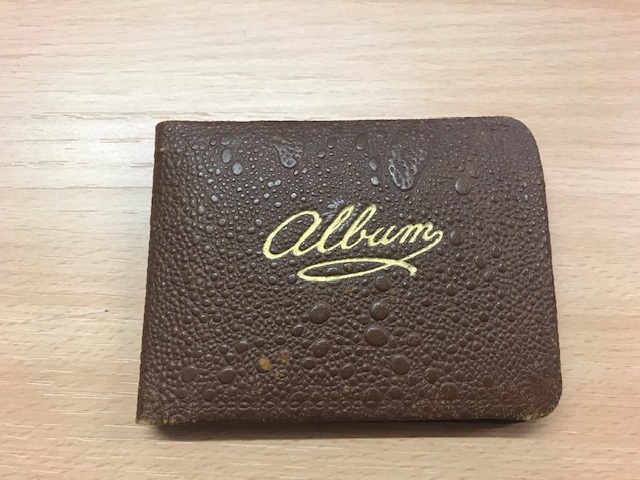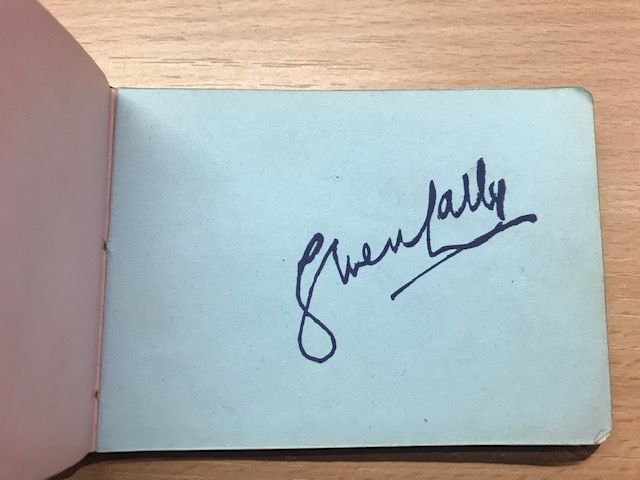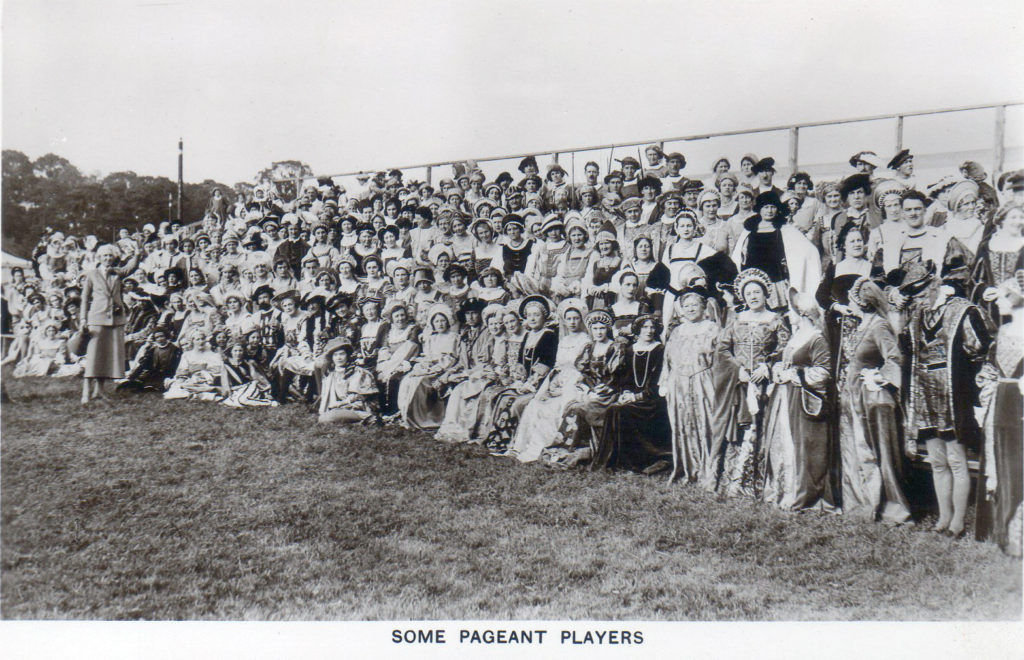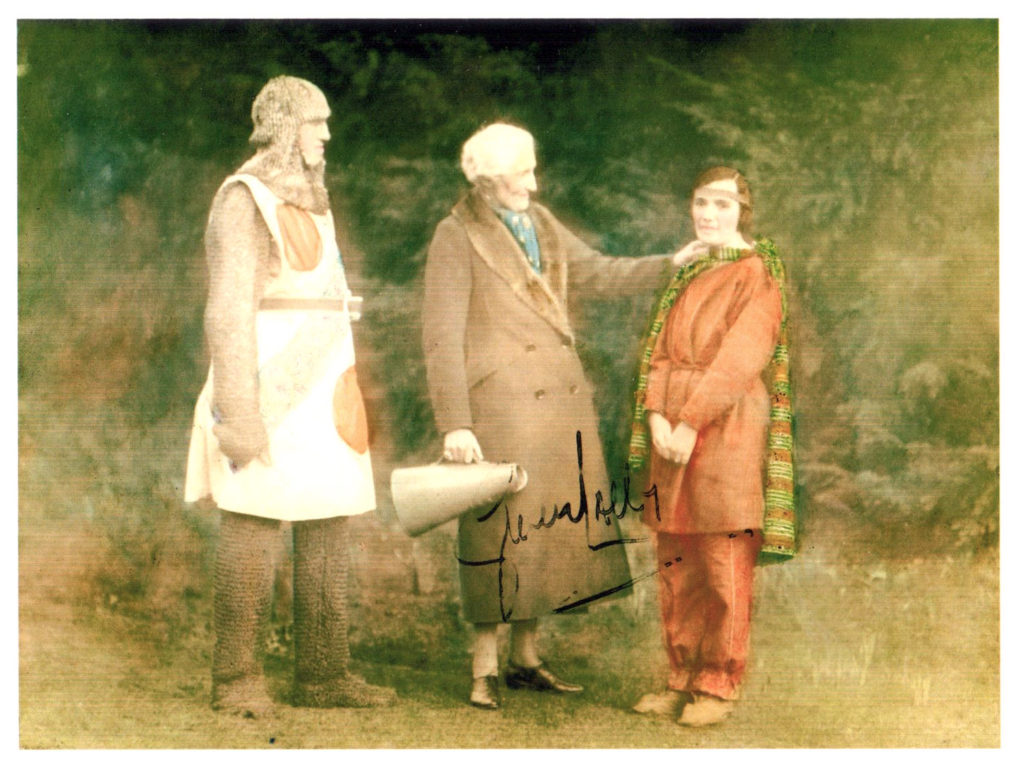Exploring Egham’s LGBTQ+ history: The Story of Gwen Lally, pageant master and queer historical figure?
Article researched and written by Maria Petts.
Gwen Lally, born Gwendoline Rosalie Lally Tollendal Speck, was a prolific producer of historical pageants, famously producing the Pageant of Runnymede in 1934. Gwen Lally was a striking figure for her time, often dressing in traditionally associated masculine styles of dress. Lally was also known for her ‘powerful personality’. A potential insight into her personality and appearance could be derived from a newspaper interview with Gwen Lally in 1932. The interviewer describes Lally’s voice as ‘neither high nor low, but beautifully modulated on the middle tones and of an extraordinarily magnetic quality.’ Furthermore, Lally’s eyes are described as ‘intensely blue…the deep-set eyes of a visionary…’ The overall impression the interviewer stated to have gained of Lally was ‘one of intense vitality; a hint of masculinity in the firmness of purpose’ and ‘…a personal magnetism that is the sum and essence of leadership.’
Recent historical research has also indicated that Gwen Lally was potentially a queer historical figure.
Though born in London in 1882, as the daughter of Canon Joceyln Speck, Lally was brought up in a vicarage on the borders of Warwickshire and Oxfordshire from the age of five. From a young age, she displayed a passion for Shakespeare and acting. Lally once stated, ‘My earliest recollections of acting was when I was about nine years old and insisted on performing ‘Romeo and Juliet’ in the nursery window seat, with myself as Romeo and my brother as Juliet!’
Image: P644, Gwen Lally, Pageant Master
Lally was privately educated and trained for the stage under Rosina Filippi, one of the founding producers of the Old Vic theatre in London. Lally began acting in 1906 at His Majesty’s Theatre London, under the management of Sir Herbert Beerbohm Tree. She often played male characters, having only played one female role throughout her acting career. The only female role Lally played was in the play Dinner Together in 1914. Interestingly, the female character was a ‘a male impersonator a la Vesta Tilley’. Vesta Tilley has been said to have been one of the best known male impersonators of her time, with a career lasting from 1869 to 1920. In 1934, Lally told the Sydney Morning Herald that she could ‘claim the distinction of being the only actress who has never worn skirts on the stage’.
During the First World War there was a shortage of male actors as many were fighting in the war. From 1914 to 1918, Lally played Lorenzo in The Merchant of Venice and Osric in Hamlet at the Old Vic. In 1916, a reviewer in The Stage commenting on Lally’s performance stated: ‘This lady is so accustomed to male parts, and presents them with such fidelity, that her sex is frequently mistaken on the stage.’
Historical Pageants:
During the Edwardian and interwar years, the popularity and interest in pageants increased significantly in Britain. Local historical pageants were dramatic reenactments of historical events with large casts of amateur performers. Traditionally performed outdoors and in places of historical significance, pageants told the history of local places through a series of episodes.
In the 1920s, Lally began to produce and direct pageants for the National Federation of Women’s Institutes. Directing and producing pageants was traditionally a heavily male dominated occupation. Lally arguably subverted gender roles through adopting the title of a ‘ Pageant Master’ rather than ‘Mistress’. She directed and produced many pageants, notably, The Pageant of Battle Abbey (1932), The Pageant of Runnymede (1934), and The Pageant of Birmingham (1938). Lally was arguably one of the most prolific pageant masters at the time, having been described as ‘England’s only woman female pageant producer’.
According to Lally, pageants brought together people of all classes and backgrounds and promoted friendships between enemies. She stated that, ‘I do find that pageant making brings the most wonderful spirit of comradeship.’ As a female pioneer in the field, Lally was awarded with an OBE in 1954.
The Pageant of Runnymede 1934:
In 1934, Lally produced and directed the Pageant of Runnymede, performed at the proposed site of the sealing of the Magna Carta, the Runnymede Meadows. The pageant was advertised as a celebration of English democracy, involving around 5000 actors and 200 horses. Over eight days, eight historical scenes were performed with the centrepiece being a recreation of the sealing of the Magna Carta. The pageant was patronised by the Prince of Wales (the future King Edward VIII) and was attended by dignitaries including the Lord Mayor of London, Lord Athlone (the former Governor-General of South Africa) and the Duke and Duchess of York (the future King George VI and Queen Elizabeth).
Image: P1201, Photograph of Gwen Lally with cast members, a Queen and ladies in waiting, Pageant of Runnymede.
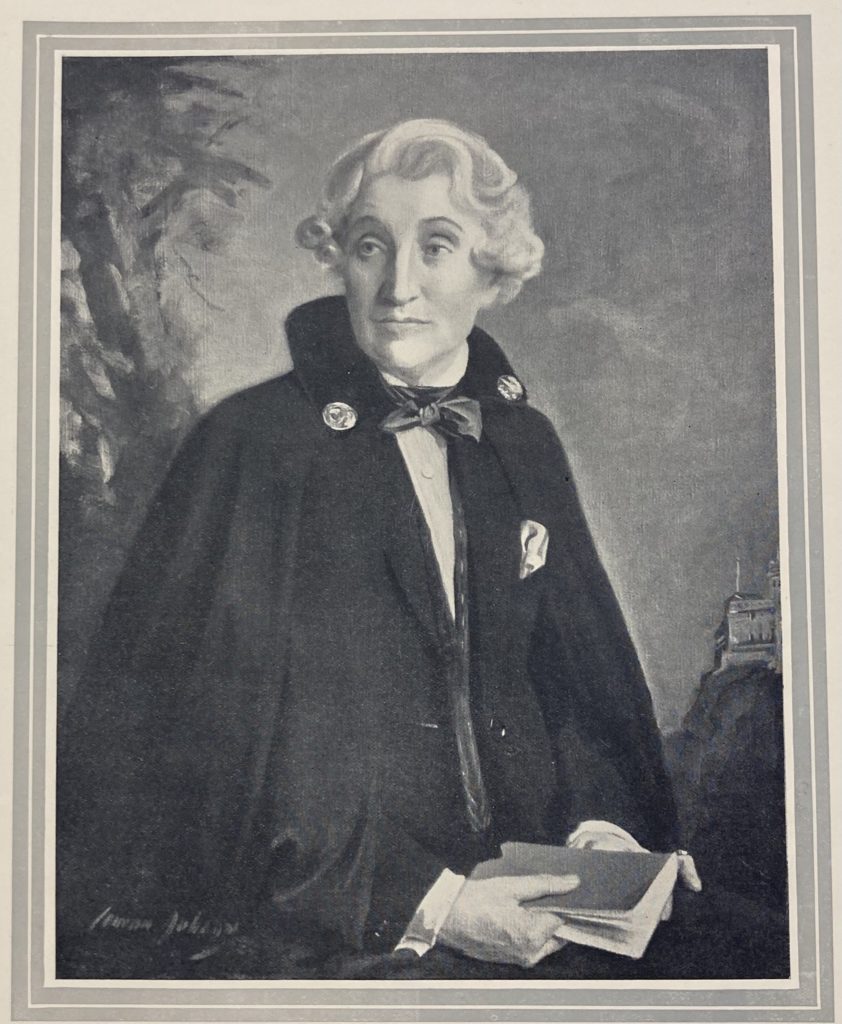
The local community of Egham played a major part in the production, volunteering as actors, staff, and costume and set designers. The costumes of actors, some of which we have in our collection, were handmade and worn by local performers playing the part of medieval barons. The yellow and blue outfit, shown below was worn by a Mr S. Smith, who played the role of the Earl of Surrey, while the maroon tunic, representing Hubert de Burgh, Earl of Kent, was worn by his wife, Mrs Smith.
In our collection we have two original autographs from Gwen Lally, along with signatures from other performers from the Pageant of Runnymede. Notably autographs include Stella Radice, Gwen Lally’s sister, Veronica Innes who played the Queen of Beauty, and a signature from ‘King John’! It could be suggested that fellow actors or audience members obtained autographs from prominent figures involved in the pageant.
Sexuality and Relationship:
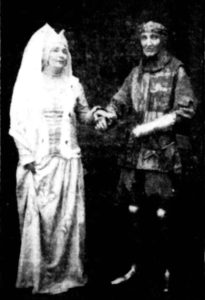
It is important to note that contemporary language surrounding sexuality and gender should not be imposed onto the past, as language and meanings have changed over time. There is no known record of Lally’s private life, though recent historical research suggests that she may have had a long lasting relationship with actress Mable (Amabel) Gibson, (1887-1979). Mabel Gibson was an accomplished actress who had worked in Canada and America. Evidence of Lally’s sexuality could be interpreted from a volume of poems published in 1907. The themes of her poems were mainly romantic and written to a female subject, who in some of the poems was addressed as ‘Phyllis’. Historian Deborah Sugg Ryan has stated that, ‘ her associations with famous feminists and self-identified lesbians at the time work together to allow us to suggest that she was a woman who fearlessly subverted the norm of early twentieth century femininity and bent the prescribed rules of gender to her will.’
Image: Banbury Guardian, Gwen Lally (right) as Henry V and her partner, Mabel Gibson, as Princess Katharine, performing at Wroxton Abbey in 1928.
Lally was known for her distinct appearance. She was tall, had short cut hair and often wore traditionally masculine clothes. Masculine dress was often very fashionable for artistic and bohemian women in the 1920s, and was not thought to be a signifier of sexuality until later years. Historian Alison Oram has stated that ‘clothing choices might have expressed increasingly fluid ideas about gender identity and sexuality, as well as sometimes simply being about fashion or practicality.’ Lally credited Gibson as her ‘partner’ in the production of some of her pageants. Lally and Gibson performed on stage together several times, typically playing romantic heterosexual couples, with Lally as the male character. In 1928, the Banbury Guardian reported that Gibson played the role of Princess Katharine to Lally’s Henry V. Sugg Ryan has suggested that the couple were ‘hiding in plain sight’.
Angela Radice, daughter in law of Stella Radice, Lally’s sister, has commented that Lally ‘was fairly open about her sexuality within the family and lived with her partner…Mrs Gibson.’ Registers reveal that Lally and Gibson lived together for almost 40 years, from at least 1924 until Lally’s death in 1963. Lally left the entirety of her estate to Gibson, who was strikingly described as a widow.
Though Gwen Lally’s sexuality cannot be known for certain, she arguably defied and subverted gender norms, through her profession, appearance and personal life, creating a significant and arguably queer legacy.
References:
Alison Oram, ‘Experiments in Gender: Women and Masculine Dress, English Heritage, https://www.english-heritage.org.uk/learn/histories/women-in-history/experiments-in-gender/
Angela Radice in Sarah Werner’s, ‘a Henry for her time’, Folger Shakespeare Library, 7 February 2013, https://collation.folger.edu/2013/02/henry-for-her-time/?unapproved=359490&moderation-hash=3758e4fc532358513742ee466bd9b5ce#comment-359490
Deborah Sugg Ryan, ‘Gwen Lally, Pageant Master’, English Heritage, https://www.english-heritage.org.uk/visit/places/1066-battle-of-hastings-abbey-and-battlefield/history-and-stories/gwen-lally/
Deborah Sugg Ryan, ‘Lally, Gwen [real name Gwendolin Rosalie Lally Tollandal Speck] (1882–1963), Oxford Dictionary of National Biography, https://www.oxforddnb.com/view/10.1093/ref:odnb/9780198614128.001.0001/odnb-9780198614128-e-59378?rskey=SNt6TE&result=2
Egham Museum, P121, P179, P644, P1201, P4763.
Egham Museum, DOC144.
Egham Museum, DOC2625.
‘Episode 1: A 1930s Pioneer- The First Female Pageant Master’, English Heritage Speaking with Shadows Podcast, https://www.english-heritage.org.uk/visit/inspire-me/speaking-with-shadows/episode-1?fbclid=IwAR0ilMgwTHYm_k2QJV1TsEeLo9uoq_JpfICwXYwLcYMS_aZWwVMdPn_na9I
‘Gwen Lally OBE (1882-1963)’, Exploring Surrey’s Past, https://www.exploringsurreyspast.org.uk/themes/people/actors/gwen-lally/
‘Miss Gwen Lally. Pageant Master and Play Producer’. The Times, (London), 17 April 1963, p.13.
‘The 1934 Runnymede Pageant’, The British Library, 30 April 2015, https://blogs.bl.uk/digitisedmanuscripts/2015/04/the-1934-runnymede-pageant.html#:~:text=Advertised%20as%20a%20celebration%20of,withdrawn%20at%20the%20last%20minute
‘The Power Behind the Battle Pageant. Magnetic Personality of Miss Gwen Lally. England’s Only Woman Pageant Producer’. Eastbourne Gazette. 24 February 1932. p. 17.
‘Trailblazing Pageant Master Organsied First Battle of Hastings Re-enactment’, University of Portsmouth, 9 October 2019, https://www.port.ac.uk/news-events-and-blogs/news/trailblazing-pageant-master-organised-first-battle-of-hastings-re-enactment

